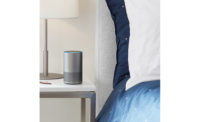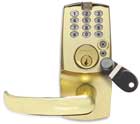
Schlage offers one-piece devices that include a keypad, card reader and lock. Some of the proximity credentials are based on an iButton design, a miniaturized form factor that can be carried on a keychain.
Security dealers today have more options than ever for controlling access to customers’ doors or other openings. In this article, we focus on stand-alone electronic lock systems that have an extra level of intelligence at the door or entry point, eliminating the need to run wiring from the door to a centralized access system controller.
Such systems have seen increased interest in recent years, particularly for companies that would like to have access control but cannot afford a centralized system. Medeco, a unit of New Haven, Conn.-based Assa Abloy, offers a stand-alone lock system under the eCylinder brand that fits in place of an existing lock and which can run as little as $500 a door, according to eCylinder director of business development Joey Kingma. Stand-alone systems that don’t fit in existing door holes can run over $1,000, Kingma says. But that’s still a significant savings in comparison with a hard-wired system, which can run as much as $3,000 a door, according to Tom Zuckerwar, marketing manager for Medeco.
“Stand-alone systems are going into areas that would have used mechanical locks before,” notes J.R. Hentschel, director of access control for Boyle & Chase, a Hingham, Mass.-based security equipment distributor. “They’re replacing traditional keys.”
Stand-alone systems may use a keypad, proximity card or combination of the two to control access. Some even support biometric readers. Any of these options eliminate the need to issue and control keys. Perhaps more importantly, if a credential falls into the wrong hands, it can be deleted from the system. If the same thing were to happen with a traditional key, the lock would have to be replaced and all users would have to be issued new keys.
Unlike mechanical locks, stand-alone electronic locks also may have an extra level of intelligence. Some systems, for example, can sound a local alarm if a door is left open too long. Increasingly, stand-alone electronic lock systems also can provide an audit trail — a capability that more and more end users are demanding. The Health Insurance Portability and Accountability Act (HIPAA) requires audit trail capability for areas where patient records are stored. And other industries are beginning to follow the health care industry’s lead, notes Bob Swoope, vice president of sales for Alarmlock, a division of Amityville, N.Y.-based equipment manufacturer Napco Security Group. “HIPAA regulations are actually being used as a guideline in non-health care environments,” Swoope says. He points to the example of auto dealers or other companies that have customer credit information on file.
Stand-alone electronic lock systems also are opening up markets that might not have used any form of access control before. As Laura Christiansen, director of marketing and business development for Brentwood, N.Y.-based equipment distributor U.S. Lock notes, “Pushbutton locks and biometrics are now more commonly used in residential applications, instead of just commercial.”
The educational market is another good target for stand-alone systems. “A lot of parents are asking, ‘How will you protect my child?’” notes Mark Brewer, access control business development manager for Assa Abloy. But as Kingma notes, hard-wired systems may be impractical for a school district with 80 buildings scattered around a city.
Since a Virginia Tech student went on a shooting spree earlier this year, the education market also has shown increased interest in stand-alone locks with lock down capability, notes Swoope, who adds that Alarmlock offers a product well suited for that purpose. “Anybody, including a student, can safely lock the classroom door without opening the door with a simple push of a button,” he explains. Security personnel, however, can use a special override key to unlock the system if needed.
Other new applications also are fueling interest in stand-alone systems. “Stand-alone access control is not only for doors now,” notes Thomas M. Botelho, national sales manager for Rosslare Security Products, an Israeli manufacturer whose U.S. office is in Southlake, Texas. He points to a dumpster manufacturer that is putting a powered keypad on its products to prevent unauthorized users from dumping trash in them.

SARGENT’s Profile Series v.N1 mortise lock integrates into an existing Wiegand-compatible access control system.
TECHNOLOGY CHOICES
The downside to stand-alone lock systems is that if an organization has multiple doors to protect, each one must be updated whenever new users are added or deleted or other changes are made to the system — a process that Brewer calls “tennis shoe-ing.” For some systems, that process involves making the same series of keystrokes at each door, which can be time-consuming and tedious. In recent years, however, manufacturers have introduced a number of advancements to simplify that process. Some systems now can be programmed from wireless hand-held programmers, which are programmed once from a personal computer, then carried to each door, where updates are automatically communicated to each lock system. Additionally, some systems enable a personal digital assistant (PDA) to be used instead of a dedicated programmer.Using either type of device, “you have the ability to bring information into a personal computer and to make all the changes you would make as if it were networked,” notes John Murzycki, senior marketing manager for International Electronics Inc., a Canton, Mass.-based equipment manufacturer. “If you want to add or delete people, you’re able to do it by having a hand-held device electronically or wirelessly communicate to the stand-alone system.”
With today’s tools, programming customer locks can be an easy way for security companies to generate additional revenue, adds Chris Nieshalla, marketing manager for Schlage Electronic Security, a unit of Ingersoll Rand Security Technologies of Carmel, Ind.
To control a stand-alone lock system via personal identification number (PIN) codes, security dealers can either install a lock/keypad combination unit or they can connect an intelligent keypad to a separate lock. The downside to keypad-based systems is that PIN code information can sometimes fall into the hands of unauthorized users, such as when an authorized user keeps it on a Post-It on his or her desk.
For an extra level of protection, some stand-alone systems use biometric or proximity readers instead of, or in addition to, PIN codes. Schlage, for example, offers one-piece devices that include a keypad, card reader and lock. Some of that company’s proximity credentials are based on an iButton design, a miniaturized form factor that can be easily carried on a keychain.
eCylinder offers yet another form factor for its stand-alone locks. Reasoning that people are accustomed to using keys, the company offers electronic locks that are opened by special keys that have built-in proximity credentials. The company also offers a digital series of electronic locks and keys that provide audit trail capability from either the lock or the key. When the key is interrogated, it provides an audit trail for the key itself.
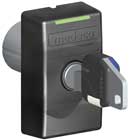
Today’s stand-alone locks can provide both mechnical and electronic security, such as this hybrid lock from Medeco.
FUTURE DEVELOPMENTS
Moving forward, some industry players expect to see heavier use of a different type of electronic locking system. By adding wireless communications capability, a lock system can communicate with a centralized access control system without the need for wiring, providing what Schlage marketing manager Felix Mira calls a “bridging” technology from traditional stand-alone electronic locking to on-line access control.In the future, Mira also expects to see two-way communications capability between locks and intelligent credentials. “There will be more interplay between the credential and the lock itself,” Mira predicts. “With read-write capability, you’ll be able to transfer and receive data from the lock to make it more efficient.”
Manufacturers also are poised to introduce new form factors to serve specific niches. Alarmlock, for example, plans to introduce a lock that requires a PIN and proximity card for exit as well as entry — a capability that could be useful for health care facilities that handle Alzheimer patients.
As a final note, it’s worth mentioning that the decision whether to use a stand-alone electronic lock or one that is integrated with a centralized access control system need not be irreversible. Some manufacturers offer lock systems that can be used either way, paving the way for easy upgrades in the future.
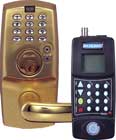
Sidebar: Simple offline access control management
From Schlage from Ingersoll Rand Security Technologies, the King Cobra Series 2 Locks work in combination with the SNAP programmer and SNAP PC application. An upgrade from mechanical keys, King Cobra 2 locks and SNAP let end users secure doors, manage lists of up to 1,000 authorized users per lock and access an audit trail of the last 1,000 users. The SNAP programmer is used to program the locks and communicates with a personal computer through a standard USB interface.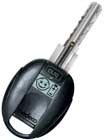
Sidebar: Get an audit trail from a key
From e-Cylinder from Medeco Security Locks, an Assa Abloy Group company, the Logic Digital Key works with the Logic Digital Cylinder to provide mechanical and electronic security. Audits can be performed at the cylinder or at the key. The latter provides a record of the key-holder’s activities. Two-year or 20,000-cycle battery. Quick and low-cost battery replacement. Up to 1,000 audit events.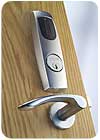
Sidebar: Lockset series provides wide range of options
From the Assa Abloy group, SARGENT, comes the Harmony lockset series, which integrates into existing Wiegand access control systems, offering complete door status monitoring and secure side electronics. The Harmony series combines SARGENT’s existing Grade 1 hardware, including bored lock (10 Line), mortise lock (8200 Series) and exit devices (80 Series) with a 125 kHz proximity reader. The lockset is available with a range of new Studio Collection lever designs and MicroShield anti-microbial coating.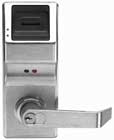
Sidebar: Narrow stile lock is keypad or PC programmable
From Alarm Lock Systems of the Napco Security Group comes the Narrow Stile Trilogy Access Lock PDL 1300, which provides pushbutton convenience for 2,000 PIN or Prox ID users and includes 40,000 event audit trails. It is keypad or PC programmable and contains automatic lock/unlock scheduling for 500 events. The product can be purchased with a retrofit kit that includes Adams Rite 4900 Series dead latch locks.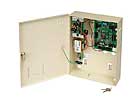
Sidebar: Stand-alone keypad can be upgraded for network connectivity
Rosslare Security Products’ convertible intelligent PIN and PIN+Prox readers function as stand-alone devices but can later be easily upgraded to SECURE Controllers with the addition of the company’s Secure Power Supply, enabling them to be connected to an Internet protocol-based network.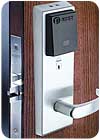
Sidebar: Lock provides multiple functions
Instead of installing reader devices, electrified strikes, door contacts and request-to-exit (RQE) devices, users can install the IDH MAX from Stanley Security Solutions’ BEST, in cylindrical or mortise lock applications. All of the formerly separate components required to control access, including passive infrared detector, RQE push buttons, door contacts and electric strike are housed in a single hardware package with only the lockset visible at the door.
Sidebar: Keypad for airports, hospitals, warehouses, and commercial facilities
Linear Corp.’s AK-3 is a low-cost interior digital keypad housed in a rugged plastic enclosure for mounting in a standard single-gang electrical box. Two indicators show system status. The left lights red to indicate power, then turns green when access is granted. The right lights yellow when the keypad is in lockout condition (from too many incorrect code entries). An interior sounder beeps when each key is pressed.Sidebar: Minimizing door wiring for centralized access control systems
Customers who want the benefits of a centralized access control system but want to minimize wiring have some innovative solutions available to them.Some manufacturers offer one-piece devices that combine an electronic lock with a proximity card or biometric reader. Although such systems still require wiring to a central controller, they minimize the amount of wiring that must be done at the door — and some customers may find such systems more aesthetically pleasing.
At press time in early summer, Assa Abloy was poised to introduce yet another alternative — a hard-wired lock that communicates with the central access control system via Ethernet. This alternative can simplify installation by using the same wiring as an organization’s data network and by using power over Ethernet to power the lock, thereby eliminating the need for a separate power supply.
